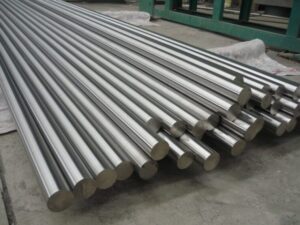
Introduction
Steel round bars are commonly used structural materials made by hot rolling and are available in different sizes, shapes, and grades depending on applications. They are mainly used in construction projects, manufacturing equipment, automobiles, and other industrial segments. Let’s explore some key details about steel round bars.
Properties of Steel Round Bars
Steel round bars have certain physical and mechanical properties that make them suitable for various structural and engineering applications. Some important properties include:
– High Strength: Different steel grades provide varying levels of strength from medium to ultra-high strength depending on their chemical composition and heat treatment process. High strength grades are preferable for load-bearing applications.
– Ductility: Steel round bars can withstand stresses and deform plastically without fracturing making them suitable for forming, machining and welding processes. Most grades have good ductility properties.
– Corrosion Resistance: Common carbon steel grades have fair corrosion resistance which can be improved by special coatings, alloying or post-manufacturing processes like galvanizing, painting etc. depending on exposure conditions.
– Machinability: Steel round bars can be easily machined, drilled, cut or threaded to required shapes and sizes with moderate-to-good machinability depending on carbon content and any additional alloying elements.
– Fatigue Strength: Under cyclic or fluctuating stresses, steel bars can withstand millions of stress reversals before failure due to stress concentration. The fatigue strength depends on surface finish and manufacturing process.
Grades of Steel Round Bars
There are various standardized steel grades developed by regulating bodies based on chemical composition and mechanical properties. Some widely used steel round bar grades include:
– Carbon Steel: Containing up to 2.1% carbon and used for general-purpose structural and mechanical applications. Grades include C10, C15, C25, C35, C45 etc.
– Alloy Steel: Added with elements like chromium, nickel, molybdenum for higher strength, wear resistance etc. Grades are 4140, 8620, 9310, EN8, EN24 etc.
– Stainless Steel: Added with minimum 10.5% chromium makes it corrosion resistant. Grades are 304, 316, 410, 420 etc.
– Tool Steel: Have best hardness and wear resistance for tools. Grades include O1, D2, M2, M42 etc.
– Structural Steels: Developed for sections and known as I-beams. Examples are A36, A242, A572 etc.
Common Applications of Steel Round Bars
Steel round bars offer versatility for use in:
– Machine Components: Connecting rods, shafts, spindles, screws, gears etc. in automotive, machinery and equipment industries.
– Construction: Reinforcement bars, dowels and anchor bolts in buildings, bridges and foundations where strength and economy is key.
– Automotive: Chassis frames, leaf springs, wheel hubs, axles etc. in cars, buses, trucks and other vehicles.
– Hand Tools: Forks, levers, wrenches, hammers etc. where toughness is important.
– Locking Devices: Bolts, screws, pins etc. that require high tensile strength.
– Bearings: Rolling element bearings like ball and roller bearings in industries and machinery.
Steel Round Bar Production Process
Steel round bars are produced through the following main steps:
– Melting and Casting: Pure iron and other alloys are melted and cast into rectangular billets or ingots in furnaces.
– Heating and Hot Rolling: Billets are reheated to 1100–1250°C and rolled into bars or rods of desired diameter in multi-stand rolling mills under heavy pressure.
– Quenching and Tempering: Selected grades are hardened by rapid water quenching after rolling followed by tempering to improve strength without brittleness.
– Inspection and Packaging: Round bars undergo various quality checks and surface finishing before packaging and shipping as per standards and customer needs.
Automation using robotic systems has increased production rates and consistency in modern steel bar manufacturing plants. Advanced thermomechanical processes are also used to develop new microstructures for enhanced properties.
Conclusion
In summary, steel round bars have become indispensable structural and engineering materials. Their versatility, cost-effectiveness, and bulk production has led to widespread applications. Newer steel grades with improved strength-ductility balance and surface coatings are expanding usage of these modular forms of steel. Adoption of advanced manufacturing will continue meeting the rising demand for steel round bars.
*Note:
- Source: Coherent Market Insights, Public sources, Desk research
- We have leveraged AI tools to mine information and compile it
